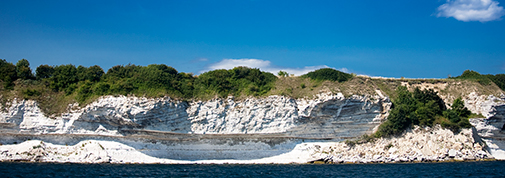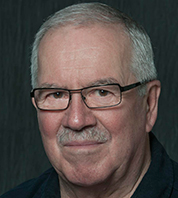Geologists from KU contribute to the inclusion of Danish cliff on the World Heritage List
It was great news for the Department of Geosciences and Natural Resource Management (IGN) as UNESCO announced that Stevns Klint was included in the World Heritage List on 23 June 2014. Several IGN staff members have been involved in the application procedure to UNESCO that lasted several years, especially Professor emeritus of Geology Finn Surlyk.

Stevns Klint. Photo: Torben Åndahl
It was great news for the Department of Geosciences and Natural Resource Management (IGN) as UNESCO announced that Stevns Klint was included in the World Heritage List on 23 June 2014. Several IGN staff members have been involved in the application procedure to UNESCO that lasted several years, especially Professor emeritus of Geology Finn Surlyk.
The great achievement builds on close collaboration between IGN, the Museum of East Zealand, and Stevns Municipality. The application to UNESCO was written by Tove Damholt from the Museum of East Zealand and Finn Surlyk, who contributed with his extensive expertise in the geology of Stevns Klint. The application presents detailed arguments for the uniqueness of the cliff. About 66 million years ago an asteroid hit the planet causing the extinction of half of all living species, including the dinosaurs. Stevns Klint is the place on Earth where the dark layer of clay that indicates this moment in history, the Cretaceous-Tertiary boundary, is most clearly visible.
The cliff thus plays a key role in documenting the development of life on our planet. Stevns Klint was also the location where the theory about mass destruction caused by an asteroid was tested for the first time 35 years ago. Samples were gathered here that showed a surprisingly high concentration of the metal iridium, compared to other elements. This concentration was only known from a specific type of asteroids from outer space. During the application process to UNESCO, postdoc Anne Mehlin Sørensen from IGN has carried out a comparative study of Stevns Klint and other locations on Earth with layers from the same age. In the study many factors were taken into consideration and the cliff did clearly stand out from the other locations.
 Finn Surlyk is very satisfied with the inclusion of Stevns Klint on UNESCO’s World Heritage List: “It is fantastic that the cliff has been added to the list. This will mean a great boost nationally, locally, and for research. Nationally, as little Denmark has now come on the world map at the same level as places like the Grand Canyon. Locally, as this will contribute to increasing numbers of tourists visiting the region and the Museum of East Zealand. Finally for research, as there will be greater awareness of this scientific subject within society and among potential funders of new research. A lot of new opportunities may arise now!”
Finn Surlyk is very satisfied with the inclusion of Stevns Klint on UNESCO’s World Heritage List: “It is fantastic that the cliff has been added to the list. This will mean a great boost nationally, locally, and for research. Nationally, as little Denmark has now come on the world map at the same level as places like the Grand Canyon. Locally, as this will contribute to increasing numbers of tourists visiting the region and the Museum of East Zealand. Finally for research, as there will be greater awareness of this scientific subject within society and among potential funders of new research. A lot of new opportunities may arise now!”
You can see a video interview in Danish about the inclusion of Stevns Klint on UNESCO’s World Heritage List with Finn Surlyk, among others, on the website of TV2 Øst.
Written by communications officer Marianne Hedegaard Forti, mfh@ign.ku.dk.
Contact
Finn Surlyk
Professor emeritus
Email: finns@ign.ku.dk
Tel.: +45 35322453 / +45 21653525
Anne Mehlin Sørensen
Postdoc
Email: anne@ign.ku.dk
Tel.: +45 35325743
Marianne Hedegaard Forti
Communications officer
E-mail: mhf@ign.ku.dk
Tel.: +45 35325864
